Gathering the required items
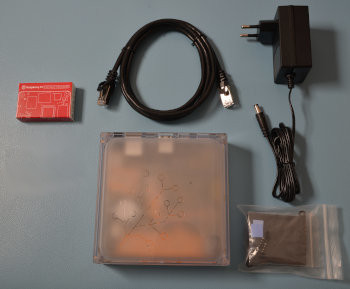
- Home Assistant Yellow
- Heat sink assembly bag
- Ethernet cable
- Power supply depending on your kit: either included power supply or PoE
Additionally, make sure you have the following items which are not part of the Kit
- Raspberry Pi Compute Module 5
- USB-C cable
- If you are using PoE, make sure your router or switch provides PoE on that port
- Optional: Power supply (12 V / 2 A, if PoE is not used)
Notice: Risk of damage to equipment Don't use screws to fix the module in place. The screws can damage the components on the CM5 module.
Screws are provided for optional use with the CM4 module only.
Opening the case
Step 1
Protecting from ESD
Grounding protects the components from the static electricity that can be naturally present (electrostatic discharge, ESD).
- Notice: Risk of damage to the equipment due to electrostatic discharge. Always: Touch the working surface before touching electronics.
- Ideally: Use ESD protective equipment, such as ESD table mats and grounding cords.
Step 2
Removing the case - bottom part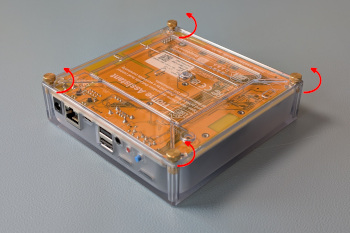
- Remove the 4 screws on the bottom of the Home Assistant Yellow Kit.
- Keep the thumb screws close by; you will need them again later.
Step 3
Removing the case - top part
- Make sure the interfaces are facing towards your left.
- Flip the case over.
- Slightly lift off the enclosure on your left.
- Slide the enclosure off towards your right.
Notice
Don't use screws to fix the module in place. The screws can damage the components on the CM5 module.
Screws are provided for optional use with the CM4 module only.
Seating the Raspberry Pi Compute Module 5
Step 1
Align the Compute Module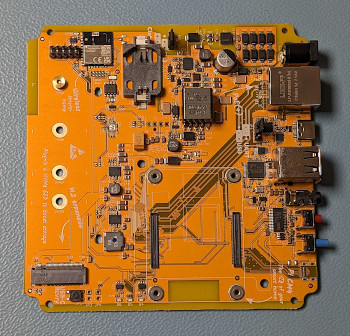
- Place the board in front of you, the red and blue buttons facing to the right.
- Orient the CM5: The Raspberry Pi text needs to be on the right hand side.
- Carefully place the CM5 without force.
- The CM5 should fall into place slightly when correctly aligned.
Step 2
Installing the CM5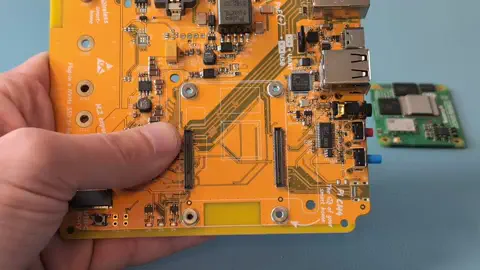
Notice: Risk of damage to equipment Don't use screws to fix the module in place. The screws can damage the components on the CM5 module.
Screws are provided for optional use with the CM4 module only.
- Press the Compute Module 5 onto the board-to-board connectors until it clicks into place.
- Make sure you press on both sides (the two long edges).
- This requires quite a bit of force. If you don't hear a loud click, it is most likely not fully seated.
- It has been reported that on some boards, there is no click sound when pressing the module onto the board. It can still be seated correctly.
- Do a visual check to make sure the module is installed correctly: it needs to run parallel to the Home Assistant Yellow board. You can also pull a bit on the sides to make sure it is not loose.
Notice: Risk of damage to equipment Don't use screws to fix the module in place. The screws can damage the components on the CM5 module.
Screws are provided for optional use with the CM4 module only.
Step 3
Placing the thermal pads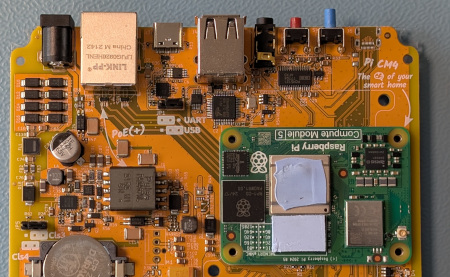
- Place the square thermal pad on the silver CPU.
- Place the rectangular thermal pad on the black rectangular chip.
Step 4
Placing the heat sink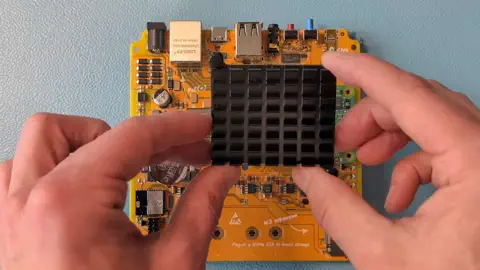
- Push the 2 plastic push pins into the dedicated hole on the heat sink.
- Start by first aligning the right plastic push pins into the dedicated hole on the carrier board.
- Then, place the heat sink onto the module.
Step 5
Securing the heat sink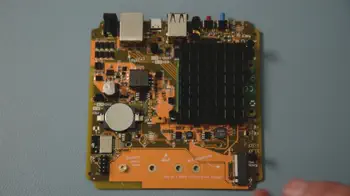
- Take the entire board off your workplace and push the pins firmly through the carrier board.
- Ensure that the module is still fully seated after securing the heat sink.
Running rpiboot
Step 1
Install rpiboot on your computer.
- rpiboot is a command line utility for booting a Raspberry Pi in USB device mode. This is needed because the CM5 cannot boot from the USB 2.0 ports of the Yellow.
- Install rpiboot on your PC.
- Windows: Download and run the Windows Installer from Raspberry Pi Github.
- MacOS or Linux: Install from
source code.
- Install rpiboot, but do not run it yet!
Step 2
Connect the Yellow to your PC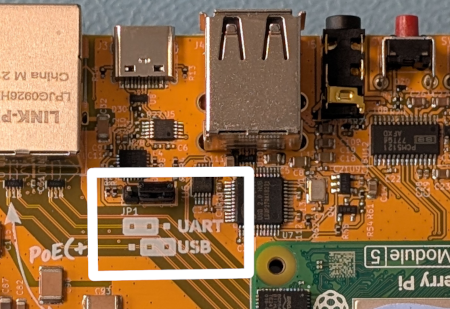
- On the Yellow board, make sure the JP1 jumper is set to USB.
- It is there by default, but it is worth to double-check.
- Plug-in a USB-C cable to Home Assistant Yellow and connect it to your PC.
- Make sure the cable supports USB 2.0 data.
Step 3
Press recovery button and power up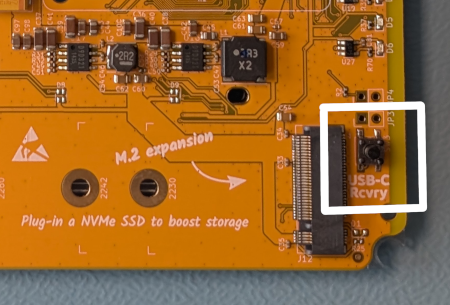
- On the Yellow board, press and hold the recovery button.
- Older Home Assistant Yellow versions: Bridge JP2 (USB-C Rcvry).
- Power up the board.
- Plug in the 12 V DC connector or Ethernet cable (if PoE is used).
- Only the red LED should be on at this point (solid, not blinking).
- Release the recovery push button.
- Older Home Assistant Yellow versions: Un-bridge JP2.
Step 4
Run rpiboot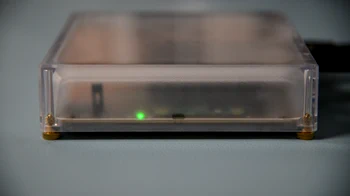
- On your PC, run rpiboot and let it run through.
- If you are using Windows, it might ask you if you want to reformat the disk. Select Cancel each time.
- If you are running an Apple Silicon mac, before running rpiboot, make sure you open the terminal using the “Rosetta” compatibility mode.
- If you are using Linux or MacOS, use
sudo ./rpiboot -d mass-storage-gadget64to run the tool.
- After a few seconds, the yellow LED on the Yellow board should start blinking.
- Afterwards, only the green LED should be on.
- The module is now ready to have the Home Assistant Operating System installed on it (next steps).
Installing Home Assistant Software on CM5
Step 1
Installing the Raspberry Pi Imager
- Install the Raspberry Pi Imager on your computer as described under https://www.raspberrypi.com/software/
- Info: If your platform doesn't support the Raspberry Pi Imager, you can use another imager (e.g. balenaEtcher) and flash the Home Assistant OS Installer for Yellow directly from GitHub releases.
Step 2
Open Raspberry Pi Imager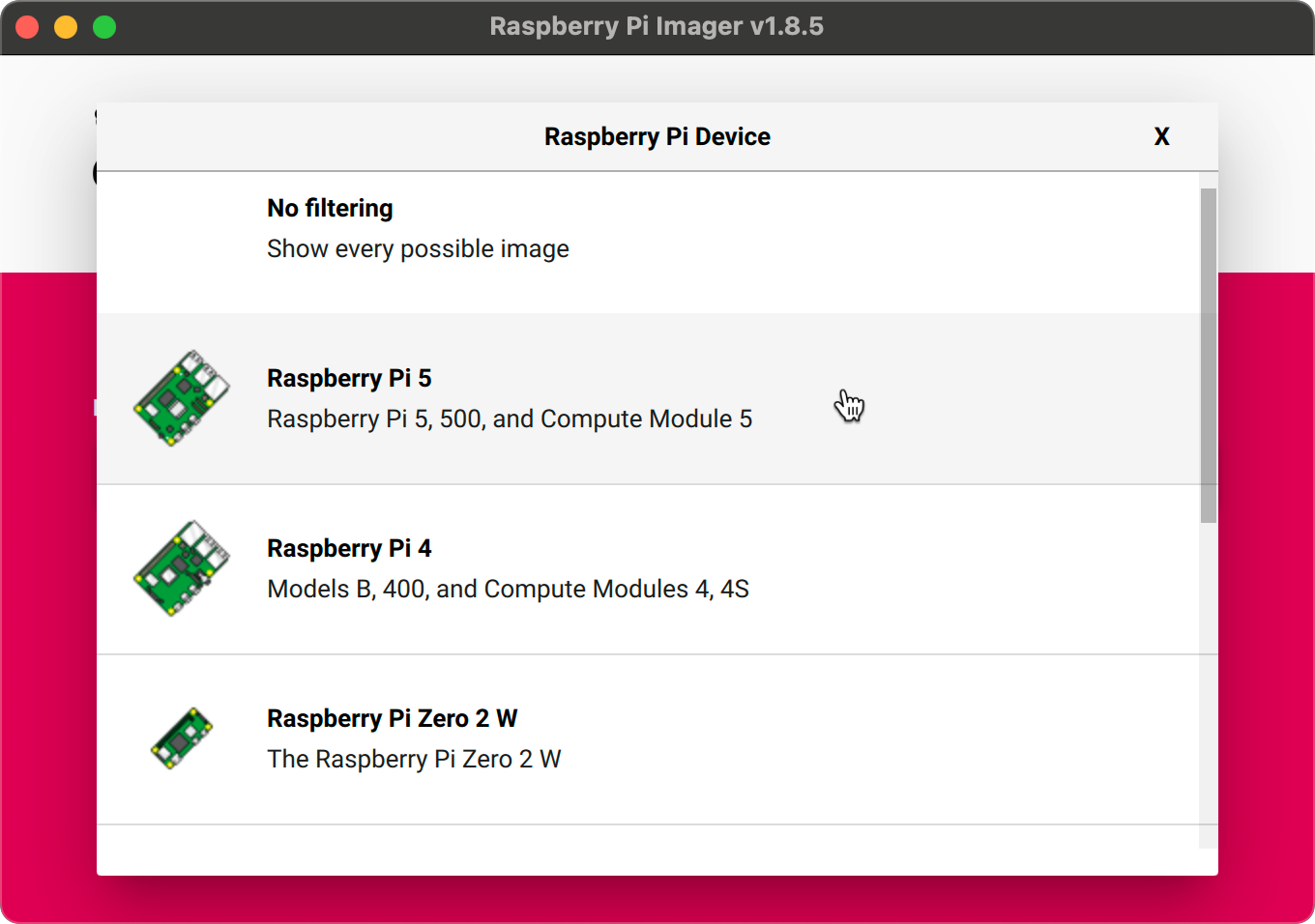
- Open Raspberry Pi Imager.
- Under Raspberry Pi Device, select Raspberry Pi 5.
Step 3
Choosing the operating system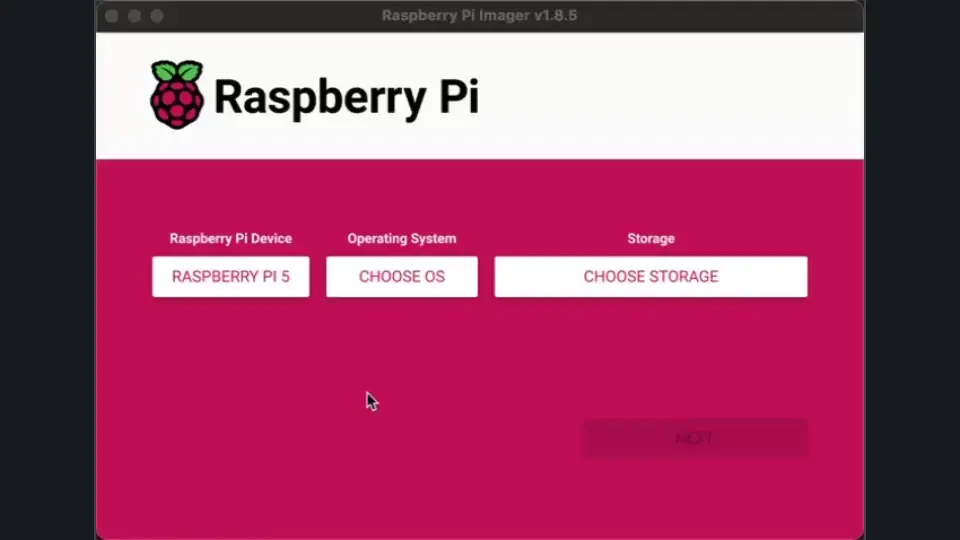
- Select Choose OS
- Choose Other specific-purpose OS.
- Choose Home assistants and home automation.
- Choose Home Assistant.
- Choose Home Assistant OS x.y (Yellow).
Step 4
Choosing storage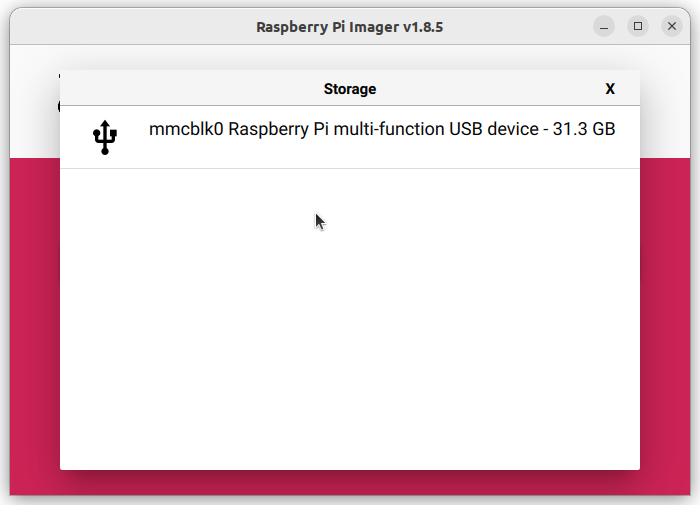
- Select Choose storage and from the dropdown menu, select your Raspberry Pi module.
Step 5
Writing the installer onto the drive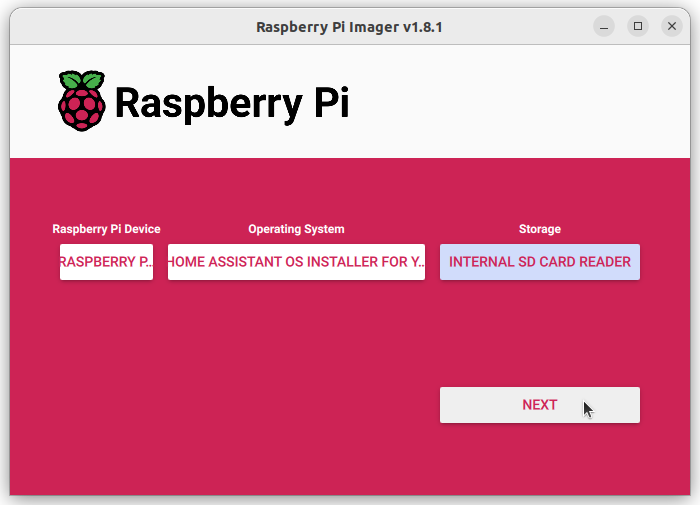
- Select the Next button to start the process.
- Wait for the Home Assistant OS Installer to be written to the internal eMMC storage on your module.
- Follow the wizard.
- When the steps are complete, close the rpi-installer.
Step 6
Unplug and set to UART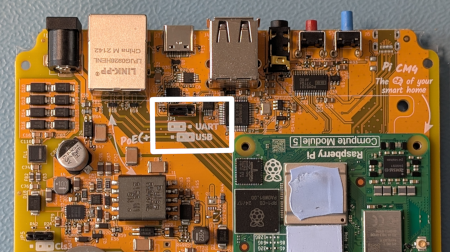
- Unplug the USB cable.
- Unplug the power cable.
- Set the JP1 jumper to UART.
Reassembling your Home Assistant Yellow
Step 1
Preparation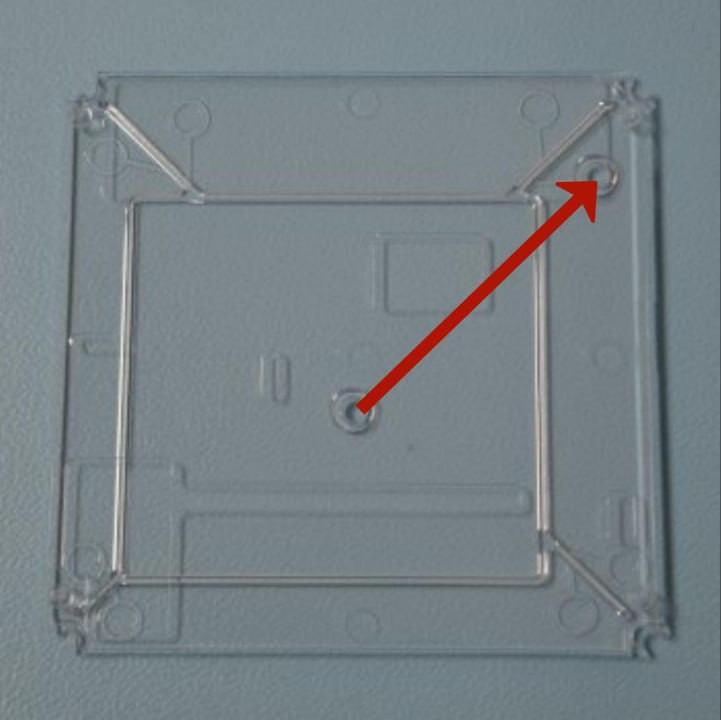
- Place the translucent bottom part of the case onto the table.
- Make sure the two round notches form a line pointing towards the top right corner.
Step 2
Reassembling - bottom part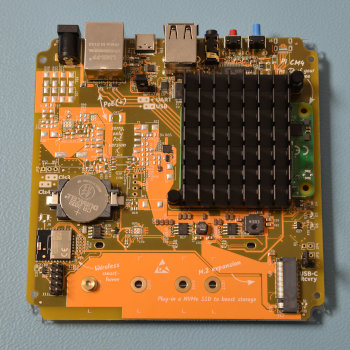
- Place the board onto the bottom part of the case.
- Make sure the USB connectors are facing upwards, away from you.
Step 3
Reassembling - top part
- Turn the enclosure upside down.
- Then, slide the push buttons into the openings of the case.
Step 4
Mounting the case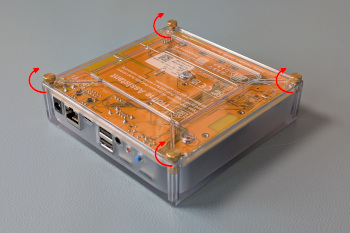
- Insert the 4 thumb screws.
- Notice: Risk of damage to the equipment due to excessive force. Do not over-tighten the screws.
Setting up
Step 1
Internet and power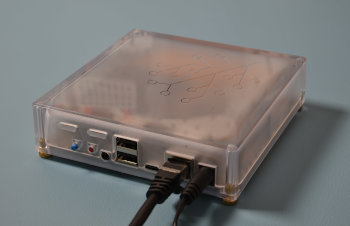
- Plug in your Ethernet cable and make sure it is locked into place.
- The other end of the Ethernet cable will need to be connected to your router or switch and connected to the internet.
- If you are not using PoE, connect the power to the wall and then to the Home Assistant Yellow.
Step 2
Getting started with Home Assistant
- Info: Initial startup may take a while, depending on your internet connection.
- Install the appTo access Home Assistant from your mobile device, use the QR code to locate the app in the app store.
- Select your Home Assistant Server:
- Mobile: Confirm the IP address detected by the app. For example: http://192.168.1.196:8123
- Desktop: Visit http://homeassistant.local:8123 to access the Home Assistant frontend.
